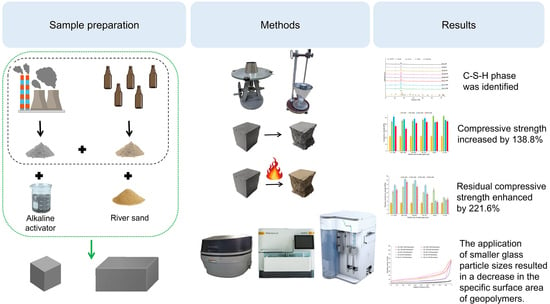Influence of Waste Glass Addition on the Fire Resistance, Microstructure and Mechanical Properties of Geopolymer Composites
Abstract
:1. Introduction
2. Materials and Methods
2.1. Materials
2.2. Geopolymer Manufacturing
2.3. Characterization of Geopolymer Samples
3. Results and Discussion
4. Conclusions
- Thermal phenomena occurring in coal fly ash-based geopolymers closely depended on the composition of the mix. Each fraction of the particle size of waste glass additive applied in an amount of 20% by weight reduced the final setting time of the geopolymer products. Furthermore, the highest energy of the exothermic reaction was released during the geopolymerization of the sample containing the smallest particles of waste glass addition (0.1–40 μm). It is noteworthy that the sample, containing 20% of unsorted waste cullet, had the shortest final setting time of all investigated materials.
- Decreasing the particle size of waste glass reduced the flow diameter and Novikov’s cone immersion depth of fresh geopolymer mortars. This effect was due to the increase of the specific surface area of decreasing waste glass, which showed a tendency to absorb a larger amount of alkaline solution. All fresh geopolymer mortars, containing up to 20% of waste glass, regardless of the particle size, had plastic consistency. In contrast, the addition of 30% of the waste cullet with particle sizes of 0.1–1200 µm or 200–1200 µm resulted in a change in the consistency of the mortar to liquid/thin.
- Samples without the addition of waste glass were characterized by the largest specific surface area. Its decrease was observed with a decrease in the size of glass particles and an increase in its share in the composite. All nitrogen adsorption–desorption isotherms of geopolymers were classified as type IV isotherms with H3 hysteresis loops, indicating the presence of mesopores. Furthermore, it was found that the smaller the particles and the higher the share of the waste glass, the lower the pore volume and diameter of the pores were.
- The water absorption of geopolymers was approximately 31%, 39%, and 43% lower for samples containing 10, 20, and 30% of waste glass with particle sizes ranging between 0.1 and 1200 μm than for reference ones. Furthermore, the addition of waste glass resulted in an increase of density by 9% (from 1.61 to 1.76 g cm−3), a decrease in the specific surface area by 26% (from 45.44 m2 g−1 to 33.67 m2 g−1), and a reduction of the total pore volume by 22% (from 0.1306 to 0.1013 cm3 g−1) by comparing the reference sample with geopolymers containing 30% of waste glass with particle sizes of 0.1–1200 μm simultaneously
- Compared to the reference samples without the addition of waste glass, the compressive strength before and after the fire resistance test of the specimens containing 20% of unsorted waste glass (particle size within the range of 0.1–1200 μm) was enhanced by 135.2% and 164.7%, respectively.
- Despite the fact that the compressive strength of the geopolymer composites increased along with the reduction of waste glass size, the use of a larger fraction of glass cullet resulted in a higher residual compressive strength determined after exposure to high temperatures. Moreover, all geopolymer samples were qualified as materials class A1fl in terms of fire resistance.
Author Contributions
Funding
Institutional Review Board Statement
Informed Consent Statement
Data Availability Statement
Conflicts of Interest
References
- Oxford Economics Future of Construction. Available online: https://www.oxfordeconomics.com/resource/future-of-construction/ (accessed on 12 April 2023).
- Luo, Y.; Jiang, Z.; Wang, D.; Lv, Y.; Gao, C.; Xue, G. Effects of Alkaline Activators on Pore Structure and Mechanical Properties of Ultrafine Metakaolin Geopolymers Cured at Room Temperature. Constr. Build. Mater. 2022, 361, 129678. [Google Scholar] [CrossRef]
- Akarken, G.; Cengiz, U. Fabrication and Characterization of Metakaolin-Based Fiber Reinforced Fire Resistant Geopolymer. Appl. Clay Sci. 2023, 232, 106786. [Google Scholar] [CrossRef]
- Rusănescu, C.O.; Voicu, G.; Paraschiv, G.; Begea, M.; Purdea, L.; Petre, I.C.; Stoian, E.V. Recovery of Sewage Sludge in the Cement Industry. Energies 2022, 15, 2664. [Google Scholar] [CrossRef]
- Karakaş, H.; İlkentapar, S.; Durak, U.; Örklemez, E.; Özuzun, S.; Karahan, O.; Atiş, C.D. Properties of Fly Ash-Based Lightweight-Geopolymer Mortars Containing Perlite Aggregates: Mechanical, Microstructure, and Thermal Conductivity Coefficient. Constr. Build. Mater. 2023, 362, 129717. [Google Scholar] [CrossRef]
- Ding, M.; Yu, R.; Feng, Y.; Wang, S.; Zhou, F.; Shui, Z.; Gao, X.; He, Y.; Chen, L. Possibility and Advantages of Producing an Ultra-High Performance Concrete (UHPC) with Ultra-Low Cement Content. Constr. Build. Mater. 2021, 273, 122023. [Google Scholar] [CrossRef]
- Zhang, Y.; Liu, H.; Ma, T.; Gu, G.; Chen, C.; Hu, J. Understanding the Changes in Engineering Behaviors and Microstructure of FA-GBFS Based Geopolymer Paste with Addition of Silica Fume. J. Build. Eng. 2023, 70, 106450. [Google Scholar] [CrossRef]
- Doğan-Sağlamtimur, N.; Bilgil, A.; Ertürk, S.; Bozkurt, V.; Süzgeç, E.; Akan, A.G.; Nas, P.; Çetin, H.; Szechyńska-Hebda, M.; Hebda, M. Eco-Geopolymers: Physico-Mechanical Features, Radiation Absorption Properties, and Mathematical Model. Polymers 2022, 14, 262. [Google Scholar] [CrossRef]
- Nodehi, M.; Taghvaee, V.M. Sustainable Concrete for Circular Economy: A Review on Use of Waste Glass. Glass Struct. Eng. 2021, 7, 3–22. [Google Scholar] [CrossRef]
- Khan, M.N.N.; Saha, A.K.; Sarker, P.K. Reuse of Waste Glass as a Supplementary Binder and Aggregate for Sustainable Cement-Based Construction Materials: A Review. J. Build. Eng. 2020, 28, 101052. [Google Scholar] [CrossRef]
- Pasupathy, K.; Ramakrishnan, S.; Sanjayan, J. 3D Concrete Printing of Eco-Friendly Geopolymer Containing Brick Waste. Cem. Concr. Compos. 2023, 138, 104943. [Google Scholar] [CrossRef]
- Yelemessov, K.; Sabirova, L.B.; Martyushev, N.V.; Malozyomov, B.V.; Bakhmagambetova, G.B.; Atanova, O.V. Modeling and Model Verification of the Stress-Strain State of Reinforced Polymer Concrete. Materials 2023, 16, 3494. [Google Scholar] [CrossRef]
- Ali, M.H.; Dinkha, Y.Z.; Haido, J.H. Mechanical Properties and Spalling at Elevated Temperature of High Performance Concrete Made with Reactive and Waste Inert Powders. Eng. Sci. Technol. Int. J. 2017, 20, 536–541. [Google Scholar] [CrossRef]
- Siddika, A.; Hajimohammadi, A.; Mamun, M.A.A.; Alyousef, R.; Ferdous, W. Waste Glass in Cement and Geopolymer Concretes: A Review on Durability and Challenges. Polymers 2021, 13, 2071. [Google Scholar] [CrossRef]
- Ahmad, S.A.; Rafiq, S.K.; Ahmed, H.U.; Abdulrahman, A.S.; Ramezanianpour, A.M. Innovative Soft Computing Techniques Including Artificial Neural Network and Nonlinear Regression Models to Predict the Compressive Strength of Environmentally Friendly Concrete Incorporating Waste Glass Powder. Innov. Infrastruct. Solut. 2023, 8, 119. [Google Scholar] [CrossRef]
- Ahmad, S.A.; Rafiq, S.K. Numerical Modeling to Predict the Impact of Granular Glass Replacement on Mechanical Properties of Mortar. Asian J. Civ. Eng. 2023, 1, 1–19. [Google Scholar] [CrossRef]
- Toniolo, N.; Taveri, G.; Hurle, K.; Roether, J.A.; Ercole, P.; Dlouhý, I.; Boccaccini, A.R. Fly-Ash-Based Geopolymers: How the Addition of Recycled Glass or Red Mud Waste Influences the Structural and Mechanical Properties. J. Ceram. Sci. Technol. 2017, 8, 411–420. [Google Scholar] [CrossRef]
- Novais, R.M.; Ascensão, G.; Seabra, M.P.; Labrincha, J.A. Waste Glass from End-of-Life Fluorescent Lamps as Raw Material in Geopolymers. Waste Manag. 2016, 52, 245–255. [Google Scholar] [CrossRef]
- Ahmad, S.A.; Rafiq, S.K.; Faraj, R.H. Evaluating the Effect of Waste Glass Granules on the Fresh, Mechanical Properties and Shear Bond Strength of Sustainable Cement Mortar. Clean. Technol. Environ. Policy 2023, 25, 1989–2008. [Google Scholar] [CrossRef]
- Henao Rios, L.M.; Hoyos Triviño, A.F.; Villaquirán-Caicedo, M.A.; de Gutiérrez, R.M. Effect of the Use of Waste Glass (as Precursor, and Alkali Activator) in the Manufacture of Geopolymer Rendering Mortars and Architectural Tiles. Constr. Build. Mater. 2023, 363, 129760. [Google Scholar] [CrossRef]
- Gao, X.; Yao, X.; Xie, R.; Li, X.; Cheng, J.; Yang, T. Performance of Fly Ash-Based Geopolymer Mortars with Waste Cathode Ray Tubes Glass Fine Aggregate: A Comparative Study with Cement Mortars. Constr. Build. Mater. 2022, 344, 128243. [Google Scholar] [CrossRef]
- Singh, S.; Srivastava, V.; Agarwal, V.C. Glass Waste in Concrete: Effect on Workability and Compressive Strength. Int. J. Innov. Res. Sci. Eng. Technol. 2007, 4, 8142–8150. [Google Scholar] [CrossRef]
- Ahmad, J.; Zhou, Z.; Usanova, K.I.; Vatin, N.I.; El-Shorbagy, M.A. A Step towards Concrete with Partial Substitution of Waste Glass (WG) in Concrete: A Review. Materials 2022, 15, 2525. [Google Scholar] [CrossRef] [PubMed]
- De Castro, S.; De Brito, J. Evaluation of the Durability of Concrete Made with Crushed Glass Aggregates. J. Clean. Prod. 2013, 41, 7–14. [Google Scholar] [CrossRef]
- Alterary, S.S.; Marei, N.H. Fly Ash Properties, Characterization, and Applications: A Review. J. King Saud. Univ. Sci. 2021, 33, 101536. [Google Scholar] [CrossRef]
- Dwivedi, A.; Jain, M. Fly Ash—Waste Management and Overview: A Review. Recent. Res. Sci. Technol. 2014, 6, 30–35. [Google Scholar]
- Luo, Y.; Wu, Y.; Ma, S.; Zheng, S.; Zhang, Y.; Chu, P.K. Utilization of Coal Fly Ash in China: A Mini-Review on Challenges and Future Directions. Environ. Sci. Pollut. Res. 2020, 28, 18727–18740. [Google Scholar] [CrossRef]
- Ćwik, A.; Casanova, I.; Rausis, K.; Zarȩbska, K. Utilization of High-Calcium Fly Ashes through Mineral Carbonation: The Cases for Greece, Poland and Spain. J. CO2 Util. 2019, 32, 155–162. [Google Scholar] [CrossRef]
- Yalcinkaya, B.; Spirek, T.; Bousa, M.; Louda, P.; Růžek, V.; Rapiejko, C.; Buczkowska, K.E. Unlocking the Potential of Biomass Fly Ash: Exploring Its Application in Geopolymeric Materials and a Comparative Case Study of BFA-Based Geopolymeric Concrete against Conventional Concrete. Ceramics 2023, 6, 1682–1704. [Google Scholar] [CrossRef]
- Doğan-Sağlamtimur, N.; Bilgil, A.; Szechyńska-Hebda, M.; Parzych, S.; Hebda, M. Eco-Friendly Fired Brick Produced from Industrial Ash and Natural Clay: A Study of Waste Reuse. Materials 2021, 14, 877. [Google Scholar] [CrossRef]
- Dong, C.; Zhou, N.; Zhang, J.; Lai, W.; Xu, J.; Chen, J.; Yu, R.; Che, Y. Optimized Preparation of Gangue Waste-Based Geopolymer Adsorbent Based on Improved Response Surface Methodology for Cd(II) Removal from Wastewater. Environ. Res. 2023, 221, 115246. [Google Scholar] [CrossRef]
- Willson-Levy, R.; Peled, A.; Klein-BenDavid, O.; Bar-Nes, G. Development of One-Part Geopolymers Based on Industrial Carbonate Waste. Constr. Build. Mater. 2023, 365, 130009. [Google Scholar] [CrossRef]
- Łach, M.; Hebdowska-Krupa, M.; Stefańska, A.; Stefanek, J.; Stanek, A.; Mikuła, J.; Hebda, M. Characterisation of Post-Production Raw Material from the Raciszyn II Deposit as a Material Suitable for the Production of Alkaline-Activated Materials. J. Therm. Anal. Calorim. 2019, 138, 4551–4559. [Google Scholar] [CrossRef]
- Ge, X.; Hu, X.; Shi, C. Impact of Micro Characteristics on the Formation of High-Strength Class F Fly Ash-Based Geopolymers Cured at Ambient Conditions. Constr. Build. Mater. 2022, 352, 129074. [Google Scholar] [CrossRef]
- McLellan, B.C.; Williams, R.P.; Lay, J.; van Riessen, A.; Corder, G.D.; Riessen, V.A. Costs and Carbon Emissions for Geopolymer Pastes in Comparison to Ordinary Portland Cement. J. Clean. Prod. 2011, 19, 1080–1090. [Google Scholar] [CrossRef]
- Srividya, T.; Kannan Rajkumar, P.R.; Sivasakthi, M.; Sujitha, A.; Jeyalakshmi, R. A State-of-the-Art on Development of Geopolymer Concrete and Its Field Applications. Case Stud. Constr. Mater. 2022, 16, e00812. [Google Scholar] [CrossRef]
- Li, S.; Liew, J.Y.R. Fire Resistance of Partially-Heated High Strength Composite Beam-Columns. J. Constr. Steel Res. 2023, 204, 107836. [Google Scholar] [CrossRef]
- Klima, K.M.; Schollbach, K.; Brouwers, H.J.H.; Yu, Q. Thermal and Fire Resistance of Class F Fly Ash Based Geopolymers—A Review. Constr. Build. Mater. 2022, 323, 126529. [Google Scholar] [CrossRef]
- Sakkas, K.; Panias, D.; Nomikos, P.; Sofianos, A.; Sakkas, K.; Panias, D.; Nomikos, P.; Sofianos, A. Comparison of Fire Resistant Geopolymers for Passive Fire Protection of Concrete Tunnel Linings. Open Access Libr. J. 2017, 4, 1–15. [Google Scholar] [CrossRef]
- Ziejewska, C.; Marczyk, J.; Korniejenko, K.; Bednarz, S.; Sroczyk, P.; Łach, M.; Mikuła, J.; Figiela, B.; Szechyńska-Hebda, M.; Hebda, M. 3D Printing of Concrete-Geopolymer Hybrids. Materials 2022, 15, 2819. [Google Scholar] [CrossRef]
- Luhar, S.; Luhar, I. Valorisation of Waste Glasses for the Development of Geopolymer Mortar—Properties and Applications. J. Compos. Sci. 2022, 6, 30. [Google Scholar] [CrossRef]
- Yang, S.; Lu, J.X.; Poon, C.S. Recycling of Waste Glass in Cement Mortars: Mechanical Properties under High Temperature Loading. Resour. Conserv. Recycl. 2021, 174, 105831. [Google Scholar] [CrossRef]
- Ling, T.C.; Poon, C.S.; Kou, S.C. Influence of Recycled Glass Content and Curing Conditions on the Properties of Self-Compacting Concrete after Exposure to Elevated Temperatures. Cem. Concr. Compos. 2012, 34, 265–272. [Google Scholar] [CrossRef]
- Chen, B.; Zhu, H.; Li, B.; Sham, M.; Li, Z. Study on the Fire Resistance Performance of Cementitious Composites Containing Recycled Glass Cullets (RGCs). Constr. Build. Mater. 2020, 242, 117992. [Google Scholar] [CrossRef]
- Tahwia, A.M.; Ellatief, M.A.; Bassioni, G.; Heniegal, A.M.; Elrahman, M.A. Influence of High Temperature Exposure on Compressive Strength and Microstructure of Ultra-High Performance Geopolymer Concrete with Waste Glass and Ceramic. J. Mater. Res. Technol. 2023, 23, 5681–5697. [Google Scholar] [CrossRef]
- Jiang, X.; Xiao, R.; Ma, Y.; Zhang, M.; Bai, Y.; Huang, B. Influence of Waste Glass Powder on the Physico-Mechanical Properties and Microstructures of Fly Ash-Based Geopolymer Paste after Exposure to High Temperatures. Constr. Build. Mater. 2020, 262, 120579. [Google Scholar] [CrossRef]
- Turkey, F.A.; Beddu, S.B.; Ahmed, A.N.; Al-Hubboubi, S.K. Effect of High Temperatures on the Properties of Lightweight Geopolymer Concrete Based Fly Ash and Glass Powder Mixtures. Case Stud. Constr. Mater. 2022, 17, e01489. [Google Scholar] [CrossRef]
- Chindaprasirt, P.; Lao-un, J.; Zaetang, Y.; Wongkvanklom, A.; Phoo-ngernkham, T.; Wongsa, A.; Sata, V. Thermal Insulating and Fire Resistance Performances of Geopolymer Mortar Containing Auto Glass Waste as Fine Aggregate. J. Build. Eng. 2022, 60, 105178. [Google Scholar] [CrossRef]
- Ziejewska, C.; Grela, A.; Hebda, M. Influence of Waste Glass Particle Size on the Physico-Mechanical Properties and Porosity of Foamed Geopolymer Composites Based on Coal Fly Ash. Materials 2023, 16, 2044. [Google Scholar] [CrossRef] [PubMed]
- Agrawal, U.S.; Wanjari, S.P.; Naresh, D.N. Impact of Replacement of Natural River Sand with Geopolymer Fly Ash Sand on Hardened Properties of Concrete. Constr. Build. Mater. 2019, 209, 499–507. [Google Scholar] [CrossRef]
- Hamada, H.; Alattar, A.; Tayeh, B.; Yahaya, F.; Thomas, B. Effect of Recycled Waste Glass on the Properties of High-Performance Concrete: A Critical Review. Case Stud. Constr. Mater. 2022, 17, e01149. [Google Scholar] [CrossRef]
- EN 1015-3:1999/A2:2006—Methods of Test for Mortar for Masonry—Part 3: Determination of Consistence of Fresh Mortar (by Flow Table). Available online: https://standards.iteh.ai/catalog/standards/cen/fb7a5bb4-d8e4-4c91-a7f8-a5cc646ce3e9/en-1015-3-1999-a2-2006 (accessed on 29 March 2023).
- PN-B-04500:1985—Construction Mortars—Tests of Physical and Strength Characteristics. Available online: https://sklep.pkn.pl/pn-b-04500-1985p.html (accessed on 29 March 2023).
- Korniejenko, K.; Łach, M.; Chou, S.Y.; Lin, W.T.; Mikuła, J.; Mierzwiński, D.; Cheng, A.; Hebda, M. A Comparative Study of Mechanical Properties of Fly Ash-Based Geopolymer Made by Casted and 3D Printing Methods. IOP Conf. Ser. Mater. Sci. Eng. 2019, 660, 012005. [Google Scholar] [CrossRef]
- EN ISO 1182:2020—Reaction to Fire Tests for Products—Non-Combustibility Test (ISO 1182:2020). Available online: https://standards.iteh.ai/catalog/standards/sist/36888eed-5e43-41c3-ad45-9078a16a66ba/sist-en-iso-1182-2020 (accessed on 29 March 2023).
- Mierzwiński, D.; Łach, M.; Hebda, M.; Walter, J.; Szechyńska-Hebda, M.; Mikuła, J. Thermal Phenomena of Alkali-Activated Metakaolin Studied with a Negative Temperature Coefficient System. J. Therm. Anal. Calorim. 2019, 138, 4167–4175. [Google Scholar] [CrossRef]
- Marczyk, J.; Ziejewska, C.; Gadek, S.; Korniejenko, K.; Łach, M.; Góra, M.; Kurek, I.; Dogan-Saglamtimur, N.; Hebda, M.; Szechynska-Hebda, M. Hybrid Materials Based on Fly Ash, Metakaolin, and Cement for 3D Printing. Materials 2021, 14, 6874. [Google Scholar] [CrossRef]
- Law, D.W.; Adam, A.A.; Molyneaux, T.K.; Patnaikuni, I.; Wardhono, A. Long Term Durability Properties of Class F Fly Ash Geopolymer Concrete. Mater. Struct. Mater. Constr. 2014, 48, 721–731. [Google Scholar] [CrossRef]
- Shee-Ween, O.; Cheng-Yong, H.; Yun-Ming, L.; Abdullah, M.M.A.B.; Li Ngee, H.; Chan, L.W.L.; Wan-En, O.; Jaya, N.A.; Yong-Sing, N. Cold-Pressed Fly Ash Geopolymers: Effect of Formulation on Mechanical and Morphological Characteristics. J. Mater. Res. Technol. 2021, 15, 3028–3046. [Google Scholar] [CrossRef]
- Hidayati, R.E.; Faradilla, F.S.; Dadang, D.; Harmelia, L.; Nurlina, N.; Prasetyoko, D.; Fansuri, H. Setting Time and Compressive Strength of Geopolymers Made of Three Indonesian Low Calcium Fly Ash with Variation of Sodium Silicate Addition. Arch. Metall. Mater. 2021, 66, 1115–1121. [Google Scholar] [CrossRef]
- Kim, B.; Lee, S.; Chon, C.M.; Cho, S. Setting Behavior and Phase Evolution on Heat Treatment of Metakaolin-Based Geopolymers Containing Calcium Hydroxide. Materials 2022, 15, 194. [Google Scholar] [CrossRef]
- Zhang, Y.; Xiao, R.; Jiang, X.; Li, W.; Zhu, X.; Huang, B. Effect of Particle Size and Curing Temperature on Mechanical and Microstructural Properties of Waste Glass-Slag-Based and Waste Glass-Fly Ash-Based Geopolymers. J. Clean. Prod. 2020, 273, 122970. [Google Scholar] [CrossRef]
- Dineshkumar, M.; Umarani, C. Effect of Alkali Activator on the Standard Consistency and Setting Times of Fly Ash and GGBS-Based Sustainable Geopolymer Pastes. Adv. Civ. Eng. 2020, 2020, 2593207. [Google Scholar] [CrossRef]
- Gholampour, A.; Danish, A.; Ozbakkaloglu, T.; Yeon, J.H.; Gencel, O. Mechanical and Durability Properties of Natural Fiber-Reinforced Geopolymers Containing Lead Smelter Slag and Waste Glass Sand. Constr. Build. Mater. 2022, 352, 129043. [Google Scholar] [CrossRef]
- Dong, W.; Li, W.; Tao, Z. A Comprehensive Review on Performance of Cementitious and Geopolymeric Concretes with Recycled Waste Glass as Powder, Sand or Cullet. Resour. Conserv. Recycl. 2021, 172, 105664. [Google Scholar] [CrossRef]
- Zhuang, S.; Wang, Q.; Zhang, M. Water Absorption Behaviour of Concrete: Novel Experimental Findings and Model Characterization. J. Build. Eng. 2022, 53, 104602. [Google Scholar] [CrossRef]
- Ding, Z.; Quy, N.X.; Kim, J.; Hama, Y. Evaluations of Frost and Scaling Resistance of Fly Ash Concrete in Terms of Changes in Water Absorption and Pore Structure under the Accelerated Carbonation Conditions. Constr. Build. Mater. 2022, 345, 128273. [Google Scholar] [CrossRef]
- Ibrahim, K. Recycled Waste Glass [WG] in Concrete. Glob. J. Eng. Sci. 2020, 6, 1–8. [Google Scholar] [CrossRef]
- Abellan-Garcia, J.; Redondo-Mosquera, J.; Khan, M.I.; Abbas, Y.M.; Castro-Cabeza, A. Development of a Novel 124 MPa Strength Green Reactive Powder Concrete Employing Waste Glass and Locally Available Cement. Arch. Civ. Mech. Eng. 2023, 23, 1–17. [Google Scholar] [CrossRef]
- Gill, P.; Jangra, P.; Roychand, R.; Saberian, M.; Li, J. Effects of Various Additives on the Crumb Rubber Integrated Geopolymer Concrete. Clean. Mater. 2023, 8, 100181. [Google Scholar] [CrossRef]
- Sunjidmaa, D.; Batdemberel, G.; Takibai, S.; Sunjidmaa, D.; Batdemberel, G.; Takibai, S. A Study of Ferrospheres in the Coal Fly Ash. Open J. Appl. Sci. 2019, 9, 10–16. [Google Scholar] [CrossRef]
- Sultan, M.; Miyazaki, T.; Koyama, S. Optimization of Adsorption Isotherm Types for Desiccant Air-Conditioning Applications. Renew. Energy 2018, 121, 441–450. [Google Scholar] [CrossRef]
- Muttakin, M.; Mitra, S.; Thu, K.; Ito, K.; Saha, B.B. Theoretical Framework to Evaluate Minimum Desorption Temperature for IUPAC Classified Adsorption Isotherms. Int. J. Heat. Mass. Transf. 2018, 122, 795–805. [Google Scholar] [CrossRef]
- Yurdakal, S.; Garlisi, C.; Özcan, L.; Bellardita, M.; Palmisano, G. (Photo)Catalyst Characterization Techniques: Adsorption Isotherms and BET, SEM, FTIR, UV–Vis, Photoluminescence, and Electrochemical Characterizations. In Heterogeneous Photocatalysis: Relationships with Heterogeneous Catalysis and Perspectives; Elsevier: Amsterdam, The Netherlands, 2019; pp. 87–152. [Google Scholar] [CrossRef]
- Luhar, I.; Luhar, S. A Comprehensive Review on Fly Ash-Based Geopolymer. J. Compos. Sci. 2022, 6, 219. [Google Scholar] [CrossRef]
- Tho-In, T.; Sata, V.; Boonserm, K.; Chindaprasirt, P. Compressive Strength and Microstructure Analysis of Geopolymer Paste Using Waste Glass Powder and Fly Ash. J. Clean. Prod. 2018, 172, 2892–2898. [Google Scholar] [CrossRef]
- Siddika, A.; Hajimohammadi, A.; Ferdous, W.; Sahajwalla, V. Roles of Waste Glass and the Effect of Process Parameters on the Properties of Sustainable Cement and Geopolymer Concrete—A State-of-the-Art Review. Polymers 2021, 13, 3935. [Google Scholar] [CrossRef] [PubMed]
- Skare, M.; Porada-rochon, M.; Blazevic-buric, S. Energy Cycles: Nature, Turning Points and Role in England Economic Growth from 1700 to 2018. Acta Montan. Slovaca 2021, 26, 281–302. [Google Scholar] [CrossRef]
- Rickard, W.D.A.; Van Riessen, A.; Walls, P. Thermal Character of Geopolymers Synthesized from Class F Fly Ash Containing High Concentrations of Iron and α-Quartz. Int. J. Appl. Ceram. Technol. 2010, 7, 81–88. [Google Scholar] [CrossRef]
- Uysal, M.; Aygörmez, Y.; Canpolat, O.; Cosgun, T.; Faruk Kuranlı, Ö. Investigation of Using Waste Marble Powder, Brick Powder, Ceramic Powder, Glass Powder, and Rice Husk Ash as Eco-Friendly Aggregate in Sustainable Red Mud-Metakaolin Based Geopolymer Composites. Constr. Build. Mater. 2022, 361, 129718. [Google Scholar] [CrossRef]
- Bisht, K.; Ramana, P.V. Experimental Investigation of Strength, Drying Shrinkage, Freeze and Thaw and Fire Attack Properties of Concrete Mixes with Beverage Glass Waste as Fine Aggregate. Structures 2022, 36, 358–371. [Google Scholar] [CrossRef]
- Mao, L.; Zhou, H.; Peng, M.; Hu, L.; Zhang, W. Effects of Waste Glass Particle Size on Improving the Property and Environmental Safety of Fired Brick Containing Electroplating Sludge. Constr. Build. Mater. 2020, 257, 119583. [Google Scholar] [CrossRef]
- Lu, J.X.; Poon, C.S. Use of Waste Glass in Alkali Activated Cement Mortar. Constr. Build. Mater. 2018, 160, 399–407. [Google Scholar] [CrossRef]
- Dehghani, A.; Aslani, F.; Ghaebi Panah, N. Effects of Initial SiO2/Al2O3 Molar Ratio and Slag on Fly Ash-Based Ambient Cured Geopolymer Properties. Constr. Build. Mater. 2021, 293, 123527. [Google Scholar] [CrossRef]

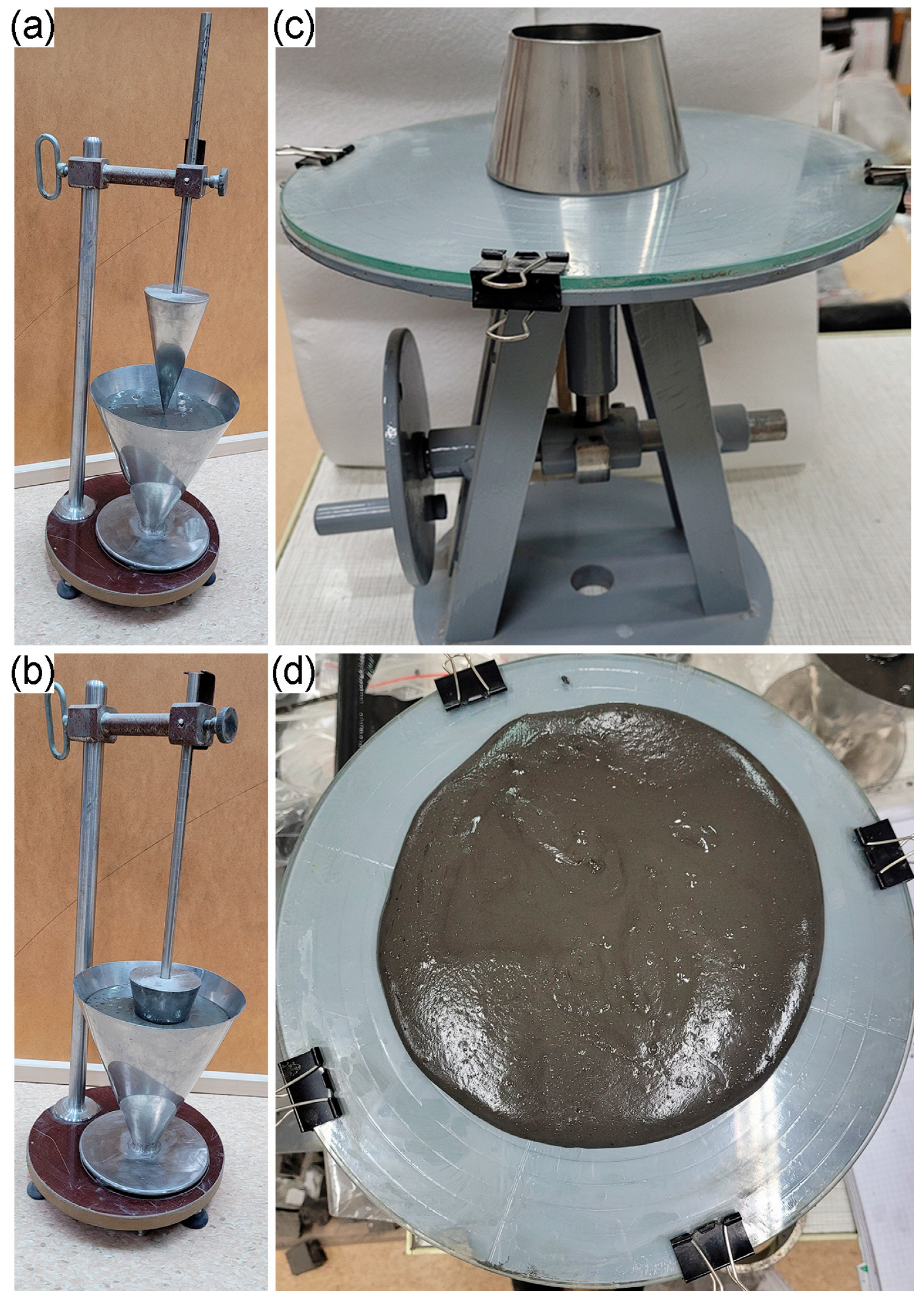
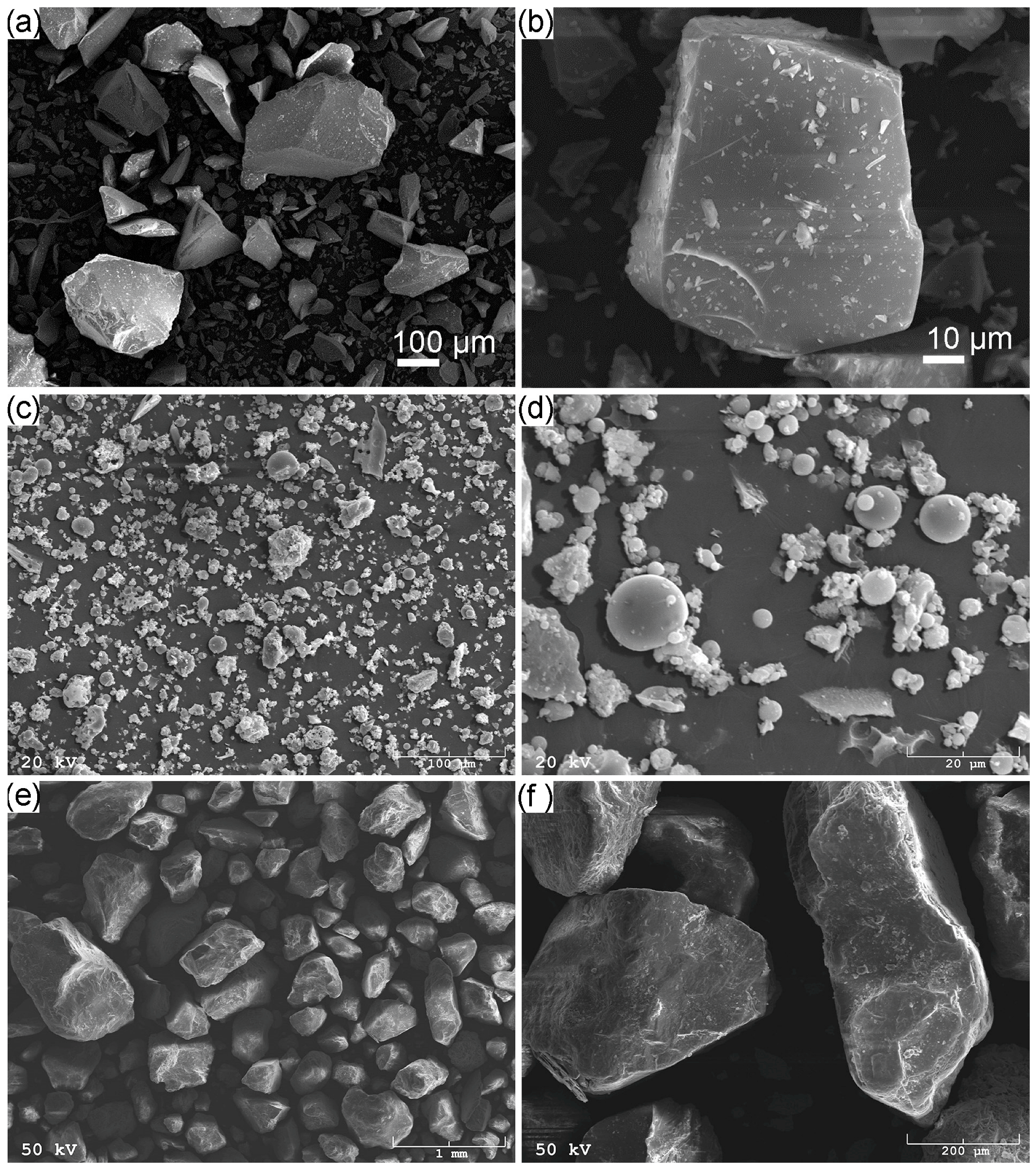


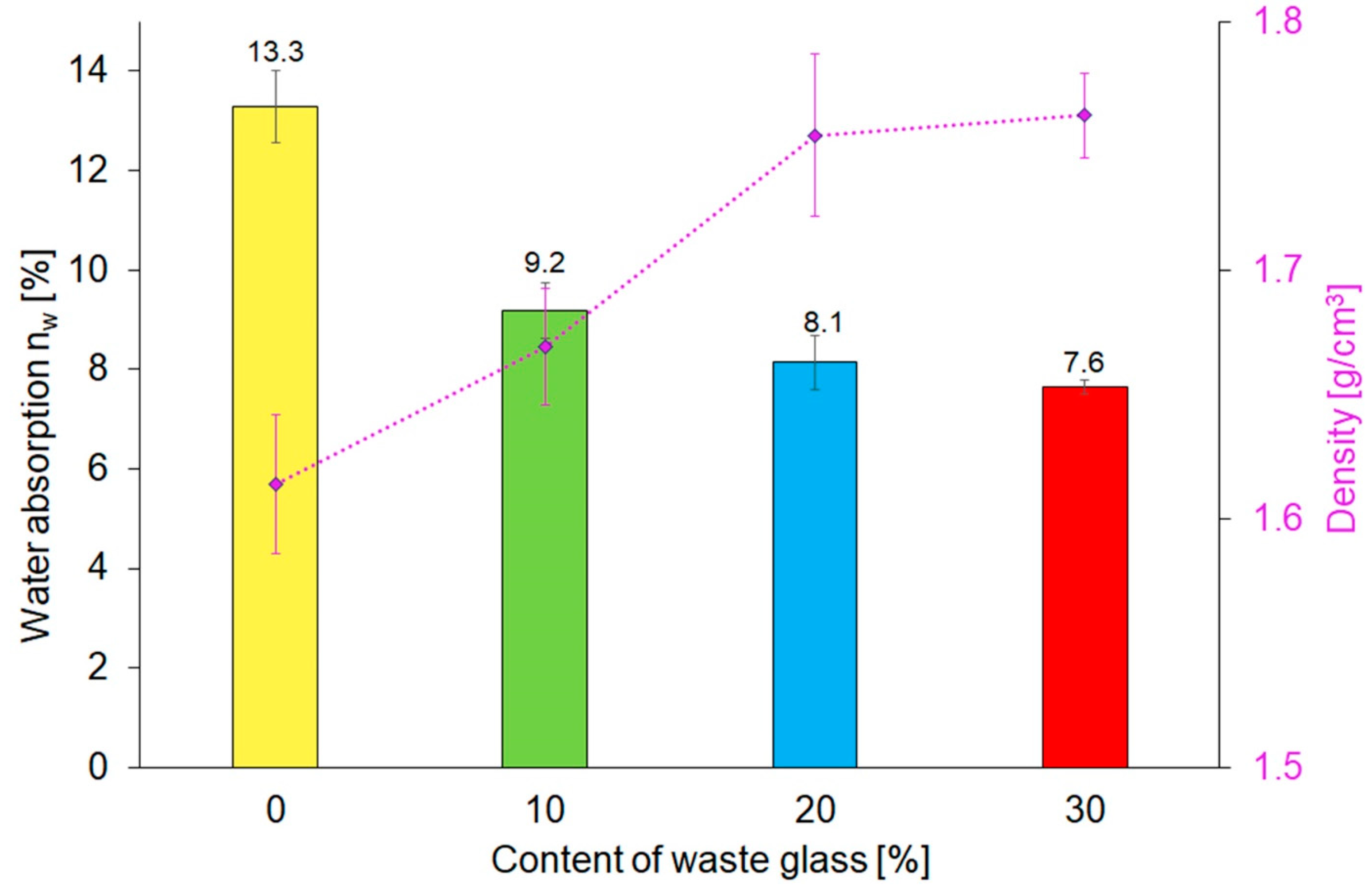
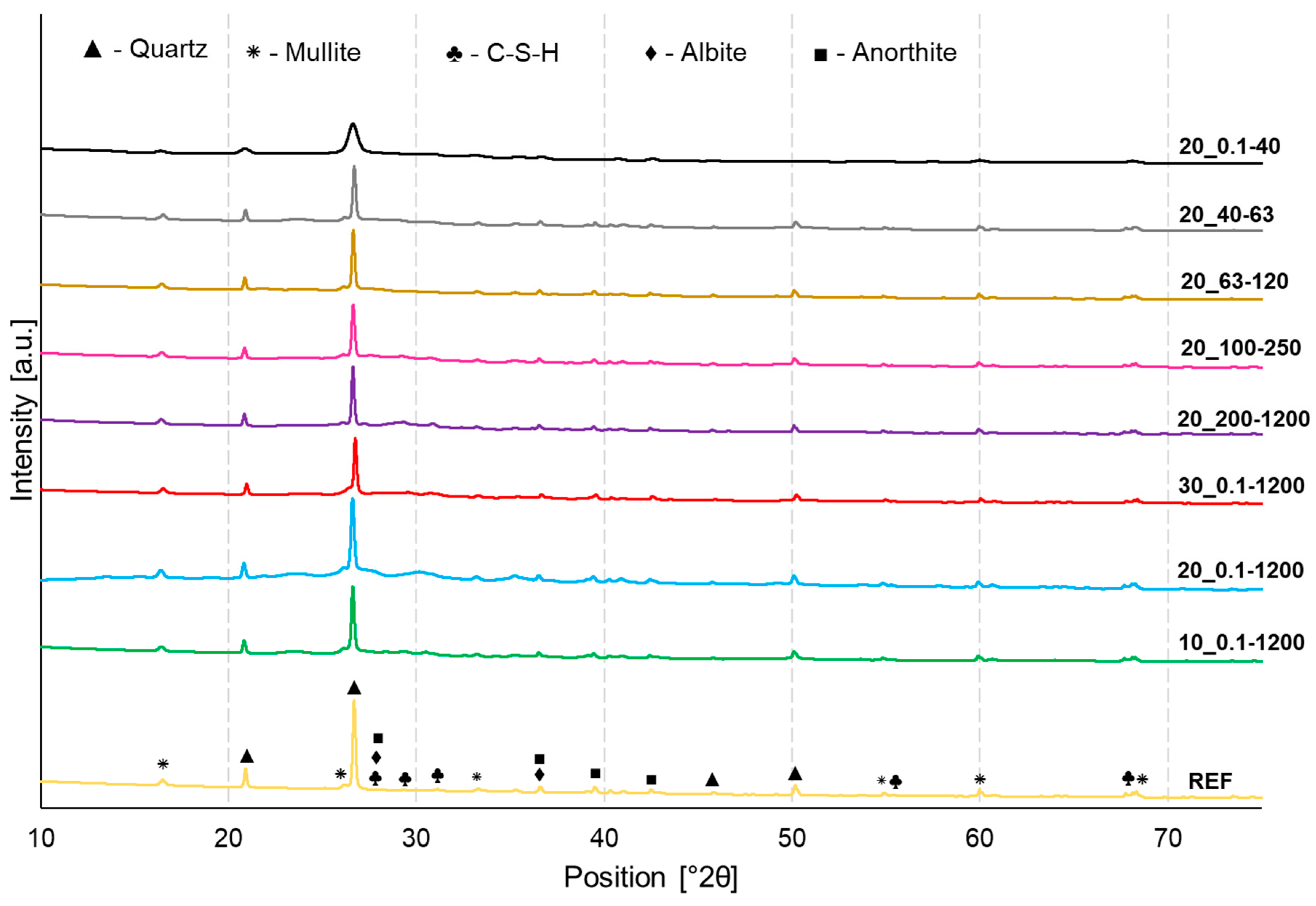


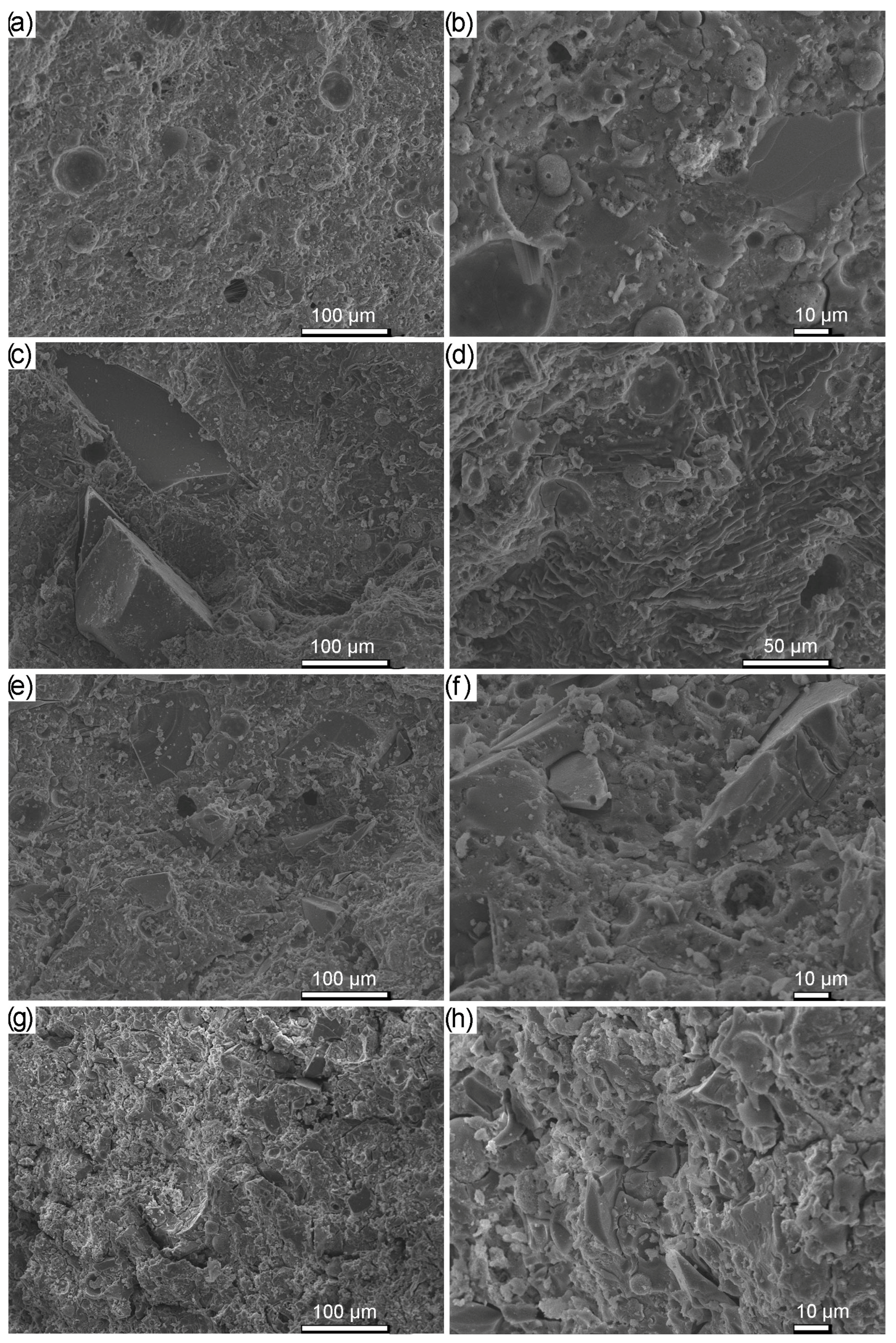
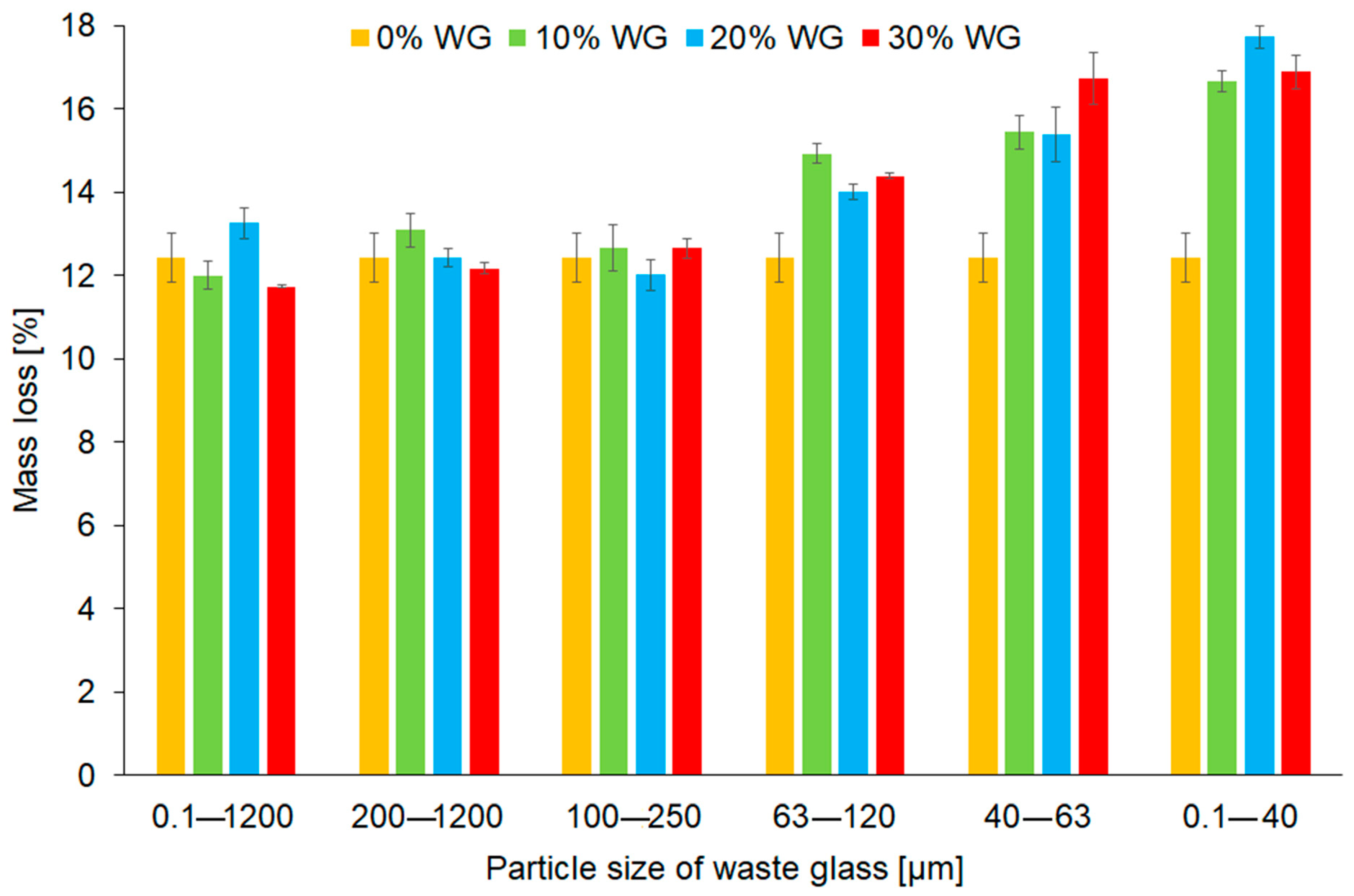
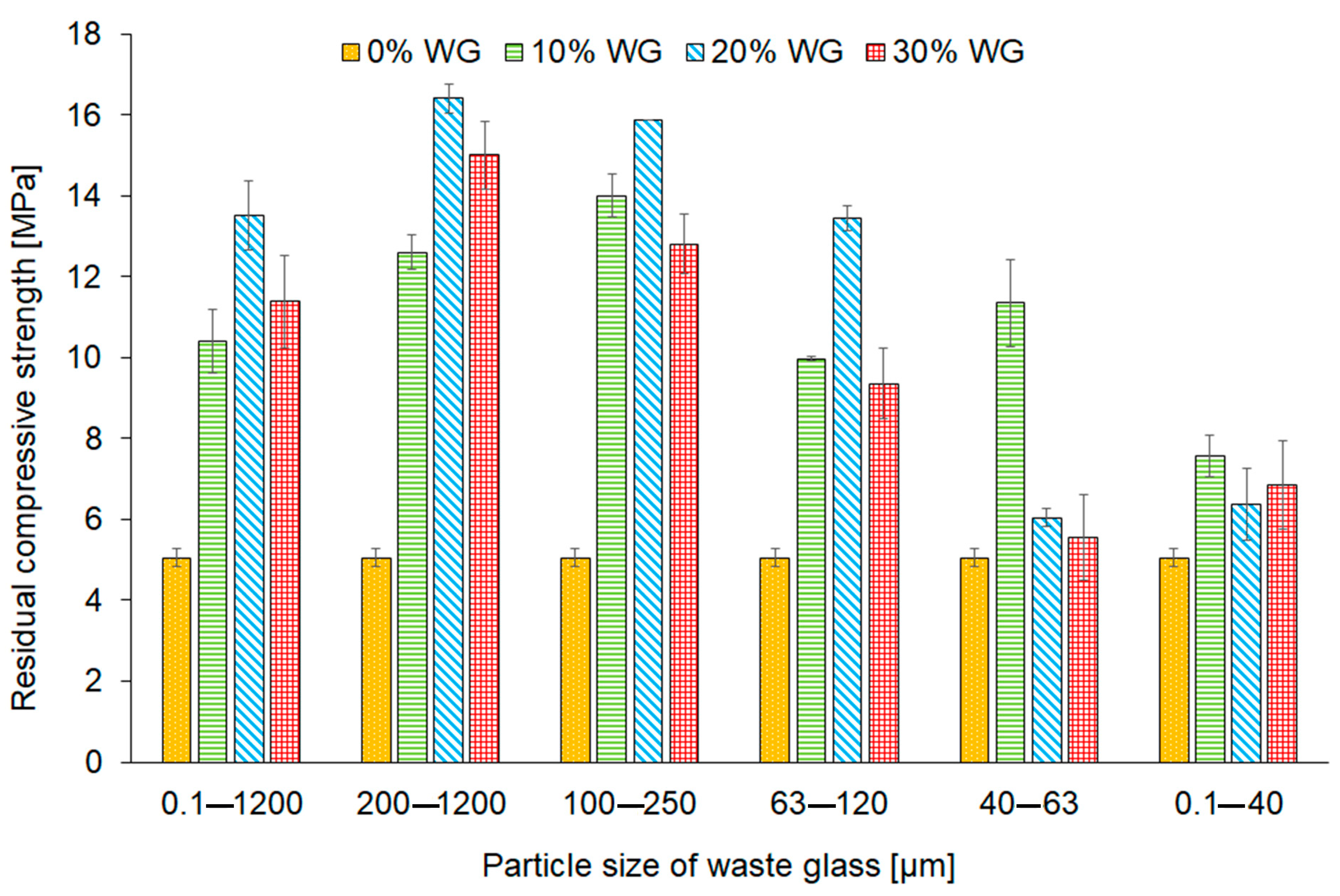
| Raw Materials | D10 | D50 | D90 | Mean | Span (D90-D10)/D50 |
|---|---|---|---|---|---|
| [µm] | [µm] | [µm] | [µm] | [µm] | |
| Fly ash | 2.3 ± 0.1 | 12.3 ± 1.3 | 37.0 ± 6.0 | 17.3 ± 2.5 | 2.8 ± 0.2 |
| Sand | 203.3 ± 13.6 | 416.2 ± 14.9 | 583.6 ± 17.2 | 450.1 ± 17.2 | 0.9 ± 0.02 |
| 0.1–1200 waste glass | 112.8 ± 8.6 | 483.4 ± 19.7 | 896.7 ± 51.1 | 550.1 ± 18.9 | 1.6 ± 0.2 |
| 200–1200 waste glass | 303.1 ± 1.6 | 584.9 ± 4.4 | 1123.3 ± 5.5 | 702.4 ± 1.6 | 1.4 ± 0.02 |
| 100–250 waste glass | 30.4 ± 1.5 | 155.2 ± 0.5 | 248.6 ± 0.2 | 160.6 ± 0.6 | 1.4 ± 0.01 |
| 63–120 waste glass | 6.3 ± 0.1 | 55.4 ± 1.2 | 118.5 ± 1.2 | 60.8 ± 0.9 | 2.0 ± 0.02 |
| 40–63 waste glass | 4.9 ± 0.1 | 33.3 ± 0.1 | 63.1 ± 0.2 | 35.1 ± 0.1 | 1.7 ± 0.01 |
| 0.1–40 waste glass | 3.9 ± 0.8 | 19.8 ± 0.3 | 39.2 ± 0.2 | 22.0 ± 0.3 | 1.8 ± 0.2 |
| Composition | Characterization of Used Waste Glass | |||||
|---|---|---|---|---|---|---|
| Sample Designation | Fly Ash [%] | Sand [%] | Waste Glass [%] | The Particle Size of Waste Glass [μm] | D50 of Waste Glass [μm] | Specific Surface Area [m2 g−1] |
| REF | 90 | 10 | - | - | - | - |
| 10_0.1–1200 | 80 | 10 | 10 | 0.1–1200 | 483.4 ± 19.7 | 0.152 |
| 10_200–1200 | 80 | 10 | 10 | 200–1200 | 584.9 ± 4.4 | 0.048 |
| 10_100–250 | 80 | 10 | 10 | 100–250 | 155.2 ± 0.5 | 0.114 |
| 10_63–120 | 80 | 10 | 10 | 63–120 | 55.4 ± 1.2 | 0.375 |
| 10_40–63 | 80 | 10 | 10 | 40–63 | 33.3 ± 0.1 | 0.594 |
| 10_0.1–40 | 80 | 10 | 10 | 0.1–40 | 19.8 ± 0.3 | 0.693 |
| 20_0.1–1200 | 70 | 10 | 20 | 0.1–1200 | 483.4 ± 19.7 | 0.152 |
| 20_200–1200 | 70 | 10 | 20 | 200–1200 | 584.9 ± 4.4 | 0.048 |
| 20_100–250 | 70 | 10 | 20 | 100–250 | 155.2 ± 0.5 | 0.114 |
| 20_63–120 | 70 | 10 | 20 | 63–120 | 55.4 ± 1.2 | 0.375 |
| 20_40–63 | 70 | 10 | 20 | 40–63 | 33.3 ± 0.1 | 0.594 |
| 20_0.1–40 | 70 | 10 | 20 | 0.1–40 | 19.8 ± 0.3 | 0.693 |
| 30_0.1–1200 | 60 | 10 | 30 | 0.1–1200 | 483.4 ± 19.7 | 0.152 |
| 30_200–1200 | 60 | 10 | 30 | 200–1200 | 584.9 ± 4.4 | 0.048 |
| 30_100–250 | 60 | 10 | 30 | 100–250 | 155.2 ± 0.5 | 0.114 |
| 30_63–120 | 60 | 10 | 30 | 63–120 | 55.4 ± 1.2 | 0.375 |
| 30_40–63 | 60 | 10 | 30 | 40–63 | 33.3 ± 0.1 | 0.594 |
| 30_0.1–40 | 60 | 10 | 30 | 0.1–40 | 19.8 ± 0.3 | 0.693 |
| Compound [%] | Fly Ash | Sand | Waste Glass |
|---|---|---|---|
| SiO2 | 52.861 | 89.099 | 68.814 |
| Al2O3 | 26.561 | 6.589 | 1.598 |
| Fe2O3 | 7.588 | 0.708 | 0.423 |
| CaO | 4.698 | 0.503 | 11.671 |
| K2O | 1.567 | 2.260 | 0.500 |
| MgO | 1.567 | 0.416 | 1.325 |
| TiO2 | 1.370 | 0.141 | 0.083 |
| SO3 | 1.095 | 0.127 | 0.051 |
| MnO | 0.108 | 0.024 | 0.050 |
| P2O5 | 0.220 | - | - |
| V2O5 | 0.089 | - | - |
| Cr2O3 | 0.038 | - | 0.047 |
| SrO | 0.081 | 0.018 | 0.024 |
| ZrO2 | 0.035 | - | 0.019 |
| PbO | 0.013 | - | 0.010 |
| ZnO | 0.032 | 0.003 | 0.005 |
| NiO | 0.012 | - | - |
| SnO2 | 0.011 | - | - |
| Ga2O3 | 0.006 | 0.005 | - |
| Y2O3 | 0.012 | 0.002 | 0.002 |
| Cs2O | - | 0.086 | - |
| Na2O | - | - | 15.285 |
| BaO | - | - | 0.084 |
| Sample Designation | Maximum Temperature during the Geopolymerization Process [°C] | Time Corresponding to the Highest Temperature [s] | Difference between the Maximum Values of Thermal Effects [°C] | Final Setting Time [s] | Energy of Exothermic Reaction [J (m × K)−1] |
|---|---|---|---|---|---|
| REF | 77.62 | 7797 | 3.19 | 26,580 | 0.66 |
| REF without sand | 77.25 | 7687 | 3.09 | 28,440 | 0.69 |
| 20_0.1–1200 | 76.65 | 7375 | 2.92 | 14,880 | 0.56 |
| 20_200–1200 | 77.00 | 7797 | 2.79 | 25,380 | 0.69 |
| 20_0.1–40 | 79.40 | 6943 | 6.36 | 24,240 | 2.60 |
| 30_0.1–1200 | 77.10 | 8446 | 2.23 | 56,880 | 0.62 |
| Sample Designation | Specific Surface Area [m2 g−1] | Pore Volume [cm3 g−1] | Pore Size [nm] | |||
|---|---|---|---|---|---|---|
| Multi Point BET Method | Single Point BET Method | Total Pore Volume at P/P0 = 0.99 | BJH Pore Volume | Average Pore Diameter | BJH Average Pore Diameter | |
| REF | 45.44 | 42.03 | 0.1306 | 0.1293 | 11.50 | 6.551 |
| 10_0.1–1200 | 44.39 | 40.76 | 0.1133 | 0.1120 | 10.21 | 6.544 |
| 20_0.1–1200 | 43.74 | 40.43 | 0.1059 | 0.1043 | 9.682 | 5.630 |
| 30_0.1–1200 | 33.26 | 31.13 | 0.09313 | 0.09171 | 11.20 | 7.799 |
| 30_200–1200 | 33.67 | 30.80 | 0.1013 | 0.1004 | 12.03 | 6.549 |
| 30_100–250 | 33.13 | 30.28 | 0.09000 | 0.08903 | 10.87 | 4.908 |
| 30_63–120 | 28.65 | 26.63 | 0.08923 | 0.08820 | 12.46 | 5.626 |
| 30_40–63 | 5.91 | 5.43 | 0.01316 | 0.01276 | 8.917 | 1.690 |
| 30_0.1–40 | 5.35 | 5.16 | 0.01141 | 0.01085 | 8.529 | 2.744 |
| Compound [%] | Before the Fire Resistance Test | After the Fire Resistance Test | ||||
|---|---|---|---|---|---|---|
| REF | 30_200–1200 | 30_0.1–40 | REF | 30_200–1200 | 30_0.1–40 | |
| SiO2 | 46.764 | 46.762 | 49.035 | 57.009 | 54.439 | 56.620 |
| Na2O | 21.564 | 27.372 | 23.861 | 16.071 | 16.371 | 20.333 |
| Al2O3 | 13.553 | 11.653 | 10.576 | 10.877 | 13.329 | 8.462 |
| Fe2O3 | 6.481 | 5.041 | 5.598 | 5.232 | 4.453 | 3.586 |
| CaO | 5.726 | 4.541 | 5.535 | 3.314 | 3.883 | 5.341 |
| K2O | 2.921 | 2.151 | 2.535 | 2.714 | 2.253 | 1.543 |
| TiO2 | 1.104 | 0.838 | 0.925 | 0.957 | 0.783 | 0.590 |
| MgO | 0.717 | 0.843 | 0.649 | 1.007 | 0.846 | 1.376 |
| SO3 | 0.435 | 0.291 | 0.715 | 2.217 | 3.020 | 1.749 |
| P2O5 | 0.329 | 0.231 | 0.179 | 0.266 | 0.298 | 0.148 |
| MnO | 0.087 | 0.071 | 0.081 | 0.088 | 0.084 | 0.068 |
| SrO | 0.076 | 0.049 | 0.067 | 0.044 | 0.043 | 0.036 |
| V2O5 | 0.067 | 0.053 | 0.073 | 0.066 | 0.096 | 0.046 |
| ZrO2 | 0.035 | 0.026 | 0.031 | 0.029 | 0.027 | 0.024 |
| ZnO | 0.029 | 0.018 | 0.024 | 0.027 | 0.024 | 0.018 |
| Cr2O3 | 0.023 | 0.028 | 0.039 | 0.021 | 0.018 | 0.030 |
Disclaimer/Publisher’s Note: The statements, opinions and data contained in all publications are solely those of the individual author(s) and contributor(s) and not of MDPI and/or the editor(s). MDPI and/or the editor(s) disclaim responsibility for any injury to people or property resulting from any ideas, methods, instructions or products referred to in the content. |
© 2023 by the authors. Licensee MDPI, Basel, Switzerland. This article is an open access article distributed under the terms and conditions of the Creative Commons Attribution (CC BY) license (https://creativecommons.org/licenses/by/4.0/).
Share and Cite
Ziejewska, C.; Grela, A.; Mierzwiński, D.; Hebda, M. Influence of Waste Glass Addition on the Fire Resistance, Microstructure and Mechanical Properties of Geopolymer Composites. Materials 2023, 16, 6011. https://doi.org/10.3390/ma16176011
Ziejewska C, Grela A, Mierzwiński D, Hebda M. Influence of Waste Glass Addition on the Fire Resistance, Microstructure and Mechanical Properties of Geopolymer Composites. Materials. 2023; 16(17):6011. https://doi.org/10.3390/ma16176011
Chicago/Turabian StyleZiejewska, Celina, Agnieszka Grela, Dariusz Mierzwiński, and Marek Hebda. 2023. "Influence of Waste Glass Addition on the Fire Resistance, Microstructure and Mechanical Properties of Geopolymer Composites" Materials 16, no. 17: 6011. https://doi.org/10.3390/ma16176011
APA StyleZiejewska, C., Grela, A., Mierzwiński, D., & Hebda, M. (2023). Influence of Waste Glass Addition on the Fire Resistance, Microstructure and Mechanical Properties of Geopolymer Composites. Materials, 16(17), 6011. https://doi.org/10.3390/ma16176011







